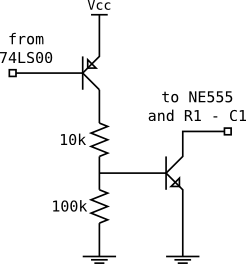csdave
Member level 5
hi all again.
I am still playing with the logics of my pet fountain circuit before on the breadboard before I turn it into something real.
Without explaining long details I am using a 555 in monostable mode with a retriggering circuit using a bc557. Basically, the transistor (a PNP) is connected with collector into GND, and emitter at the + of the monostable capacitor (pins 6,7 on the 555) which is in turn, pulled up to Vcc by a charging resistor. Cap is 100uF and restistor O(1Mohm) to yield order of 100sec.
Things worked fine when I was driving the base of the bc557 from another 555 or from a 74HCT74. Tonight, however, I tried adding a different feature and since I had nothing else to use I stuck in a 74LS00 and tried driving the bc557 from it.
The transistor correctly discharges the capacitor when the output of the 74LS00 is low. However, when the output of the gate and the base of the transistor are high (4.3V approx) the capacitor does not charge above 2.5v. The base-emitter junction should be inversely polarized and the transistor should be off... but still it looks like it's stealing current from the capacitor!
What is the problem?
Thanks
Davide
I am still playing with the logics of my pet fountain circuit before on the breadboard before I turn it into something real.
Without explaining long details I am using a 555 in monostable mode with a retriggering circuit using a bc557. Basically, the transistor (a PNP) is connected with collector into GND, and emitter at the + of the monostable capacitor (pins 6,7 on the 555) which is in turn, pulled up to Vcc by a charging resistor. Cap is 100uF and restistor O(1Mohm) to yield order of 100sec.
Things worked fine when I was driving the base of the bc557 from another 555 or from a 74HCT74. Tonight, however, I tried adding a different feature and since I had nothing else to use I stuck in a 74LS00 and tried driving the bc557 from it.
The transistor correctly discharges the capacitor when the output of the 74LS00 is low. However, when the output of the gate and the base of the transistor are high (4.3V approx) the capacitor does not charge above 2.5v. The base-emitter junction should be inversely polarized and the transistor should be off... but still it looks like it's stealing current from the capacitor!
What is the problem?
Thanks
Davide
